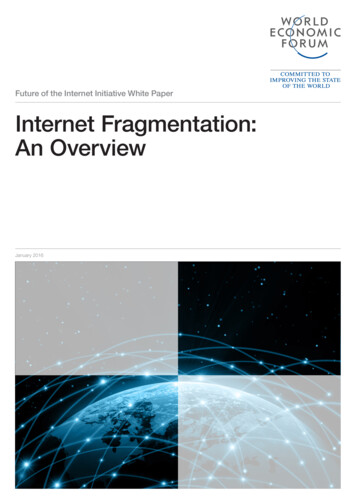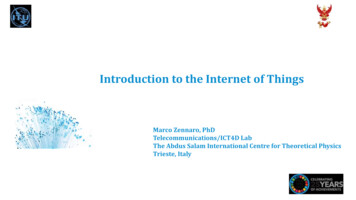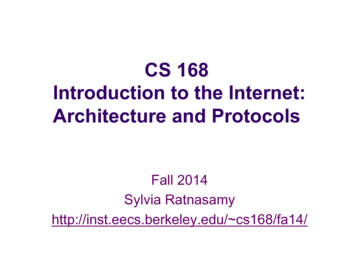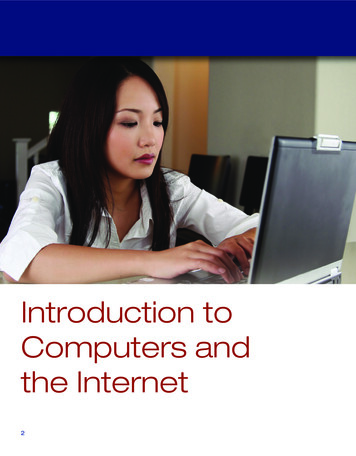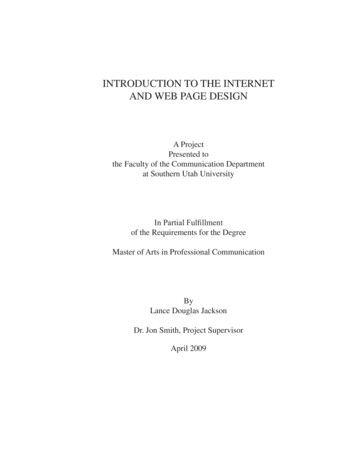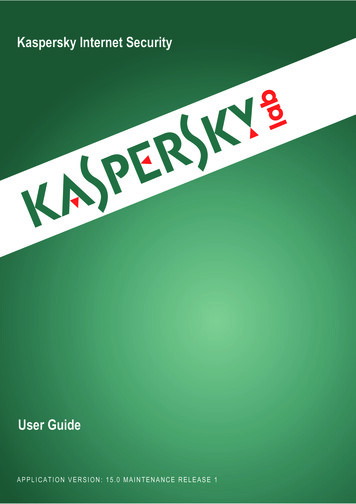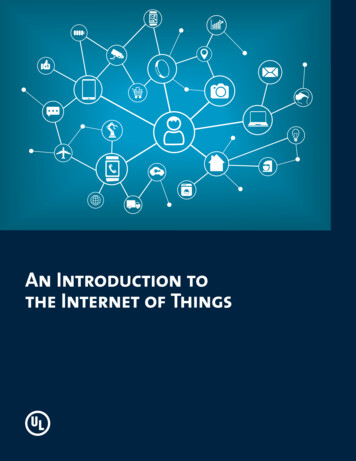
Transcription
An Introduction tothe Internet of Things
An Introduction to the Internet of ThingsThe concept of the “Internet of Things” (IoT) is no longer the stuff of science fictionbut an essential part of the reality of our everyday lives. Today, there are more than 13billion interconnected digital and electronic devices in operation globally, the equivalentof nearly 2 devices for every human on earth. Although the most common examples ofthe IoT consist of so-called “smart home” devices such as programmable thermostatsand remote controlled appliances, the largest share of future growth of the IoT is likelyto come from applications of the technology in virtually every sector of the economy,from commercial and industrial environments to healthcare and public safety.In this UL white paper, we’ll provide readers with a general introduction to thetechnologies and standards that are expected to support the continued widespreaddeployment of the IoT. Beginning with an overview of current and future IoTapplications, the paper will then discuss the specific technologies that make the IoTpossible, and provide details on current standards development activities in progress.The white paper will conclude with a preview of the future standards and regulatorylandscape.The Promise of the Internet of ThingsThe “Internet of Things” (sometimesalso referred to as the “Internet ofEverything,” or IoE) generally refers tothe multiple networks of devices ortechnology platforms (“things”) thatcommunicate with each other via wirelesssystems, vehicular traffic managementand healthcare services. Indeed,technology research and consultingfirm Beecham Research has identifiednine different IoT service sectors and 29separate applications for current andpotential IoT development or expansion.protocols and without direct humanThe potential in this broad applicability ofinteraction. Connections made throughIoT technologies is reflected in projectionsIoT-enabled devices facilitate the rapidof future IoT market revenue and growth.and efficient transfer of data needed toIDC Research estimates that the globalsupport a wide range of activities andmarket value for IoT products and devices,operations. In this way, the application ofcurrently about 655 billion (USD), willIoT technologies can lead to significantincrease to 1.7 trillion by the year 2020, aoperational improvements, such ascompound annual growth rate (CAGR) ofincreased efficiency, better performance16.9 percent. A separate projection fromand enhanced safety.ABI Research indicates that the numberMany think of the IoT as a singleglobal network. But the IoT actuallyencompasses a multitude of independentbut complementary networks in variousservice sectors, such as those supportingefficient energy distribution and usage(so-called smart grids), home automationpage 2of IoT-connected devices will increasefrom around 16 billion in 2014 to nearly41 billion by 2020. Clearly, leveragingthe growth potential of the IoT is likely tobe an essential element of the strategyof technology companies in the years tocome.
An Introduction to the Internet of ThingsThe IoT Landscape: Current andPotential Applicationstransportation applications are alsorequired. And IoT technologies canbeing applied to public transportationmonitor inventory levels and rawToday’s IoT is already bringing advancedsystems, helping to balance capacitymaterial usage, helping to optimizetechnological capabilities to multiplewith anticipated ridership in real time,inventory investment.consumer, commercial and industrialand providing riders with accuratemarket segments. Some examples ofscheduling information.current and potential applications for IoT Energy infrastructure and distribution— The environment—Finally, IoTtechnologies are being used to monitorenvironmental conditions that couldtechnologies include:Smart grid technologies areaffect human, animal or plant life. Consumer and residential—IoTtransforming the way in which energyIoT-equipped sensors can be used toapplications in these marketis produced and distributed, enablingdetect rising water levels in rivers andsectors include domestic and homeutility operators to more accuratelystreams that could lead to flooding,automation tools, such as remoteestimate usage and to source energyincreases in air pollution levels duemonitoring and control of appliances,from the most cost-effective suppliers.to automobiles or industrial activity,lighting, heating and air conditioning,IoT smart grid applications can alsolocalized atmospheric conditions thatwater usage, entertainment systemsenable energy users to more effectivelycould portend an increased risk ofand premises security. Also included inmonitor and control their energy usage,forest fires, and even vibration patternsthis category are wearable consumerthereby reducing consumption as wellthat could signal risk of an earthquake,devices, such as smart watches andas the need for added infrastructure.landslide or avalanche.smart eyeglasses, and clothing withembedded technologies. Public safety—Cities and towns areThese examples represent just a smallquickly adopting IoT technologies tosampling of the myriad of current IoTimprove public safety and services.applications, and illustrate some ofinclude personal health and fitnessIn some cases, these efforts leveragethe many potential benefits that candevices that monitor physical activity,the transportation applicationscome from the continued growth andsuch as wrist bands and other wearablenoted previously to help reduce citydeployment of IoT technologies.devices. They also include m-Healthcongestion. Other examples includetechnologies that monitor and recordsmart phone apps for paying parkingvital patient data in real time, or thatmeter fees, or for reporting potholes orenable healthcare professionals tonon-working traffic lights. Still othersThe deployment of the IoT is based onretrieve and update patient medicalcan help city officials monitor crimea handful of enabling technologies.records from any location. Andactivity, allowing for the effectiveThese include communications networksm-Health technologies will enableallocation of limited law enforcementand protocols, hardware devices andbaby-boomer generation adults withresources.components such as sensors, wireless Health and healthcare—These marketsthe ability to age in place, helping Industrial and manufacturing—IoTEnabling Technologies That Will DriveIoT Growthcharging technologies and software.to reduce their overall impact ontechnologies, such as so-calledCommunications Networkshealthcare costs.machine-to-machine (M2M)An IoT network can be defined by theapplications, are being widely adoptedtotal area within which IoT devices aretransportation sector include smartin support of industrial automationexpected to operate. A local area networkcars and smart roadways that canto increase productive efficiency and(LAN) usually covers an area the size of anhelp manage the flow of traffic andflexibility. IoT sensors can also be usedoffice or home, within which devices areminimize congestion, and applicationsto monitor manufacturing equipmentdirectly connected either by wire, such asthat identify vacant parking spaces. IoTto determine when maintenance istwisted-pair or coax cable, or wirelessly Transportation—IoT applications in thepage 3
An Introduction to the Internet of Thingsusing a wireless communications Bluetooth and variants—The Bluetoothmore secure than those utilizing otherprotocol. Smart home IoT technologiesprotocol (based on IEEE 802.15.1) alsocommunications protocols. Furthertypically operate in a LAN environment.operates in LAN-based environmentsNFC devices transmit data at relativelyat distances typically up to 10 meters,low rates, resulting in reduced energyalthough some Bluetooth-enabledconsumption.A wide area network (WAN) covers a muchlarger area, such as a group of buildingsor remote locations. Connections aremade with either fiber optic cable orwirelessly using microwave or satellitetransmissions. A WAN may also consist ofa series of interconnected networks, suchas the Internet or an intranet. Most IoTtechnology applications, other consumeror residential applications, operate withina WAN environment.devices will work at distances of upto 100 meters. Bluetooth’s principleadvantages are its low rate of powerconsumption, the capacity to handlemultiple devices simultaneously,and its ability to transmit wirelesslywithout visual line of sight contact. ABluetooth variant, Bluetooth LE (alsoknown as Bluetooth Smart) offersall of Bluetooth’s communicationsAt the other end of the spectrum areadvantages at significantly reducedpersonal area networks (PANs), whichpower consumption rates.typically cover a small area, such as aroom. PAN-based IoTs enable the wirelessconnection of computers with printersand other peripherals, entertainmentsystems with headsets and remotecontrols. And body area networks (BANS)provide connectivity between a variety ofwearable technologies and smart clothes,and even implanted devices.Wireless Communications ProtocolsMost IoT applications require the useof wireless communications protocolsto enable the transmission of databetween devices. There are a numberof wireless communications protocolsthat are currently used to support IoTtechnologies. Some of the more widelyused communications protocols include: Wi-Fi—A protocol for LAN-based IoTapplications, Wi-Fi is based on the IEEE802.11 series of standards. Wi-Fi workswithin the 2.4-5GHz frequency band toconnect wireless devices to a networkaccess point, and has an indoor rangeof about 20 meters.page 4 Near Field Communications—Nearfield communications is intended foruse in PANs between devices that arewithin close proximity to each other,typically less than 20 centimeters(about eight inches). The limitations in Zigbee—Based on IEEE 802.15.4, Zigbeeis designed for use in IoT applicationsoperating in PAN environmentsthat require secure networking andlong battery life (at least two years)but that are not data transmissionintensive. Zigbee-based IoT devicescan communicate via line of sight atdistances between 10 and 100 meters. ZWave—Zwave is a LAN environmentcommunications protocol specificallydesigned for use with compatible homeautomation controls. It operates infrequency bands below 1 GHz, therebyavoiding interference from devices thatwork on other wireless communicationsprotocols.their effective operating range help toThe appropriate wireless protocol formake NFC-enabled devices inherentlya given IoT device is usually prescribed
An Introduction to the Internet of Thingsby a number of factors, including theSoftwaredevelop open source specificationstype of communications network withFinally, like most technology platforms,to support interoperability betweenwhich the device is intended to operate,the IoT depends on multiple types ofvarious types of IoT technologies. Theanticipated data rate requirements, thesoftware. These include IoT platforms andOIC’s lead standards developmentavailability of energy needed to supportprotocols, embedded operating systemsproject is IoTivity, an open sourcecommunications transmissions, andand dedicated IoT applications. Certainsoftware framework that will enableany application-specific requirementssoftware tools are intended for use withseamless connectivity between IoTregarding security.specific IoT applications, such as thosedevices operating across multipleSensorsintended to support smart home devices.operating systems and networkIn addition, some software is proprietaryprotocols.Sensors are low-powered, wirelessmicroelectronic devices that are designedto monitor a specific physical, electricalor chemical element and to transmit dataon changes in that element over time. Asensor can be a simple, single-functiondevice designed for a specific application,or integrated into a computing devicesuch as a smart phone. But, regardless ofthe form that they take, sensors are anessential technology in the IoT universesince they enable the efficient collectionand transfer of data.Charging TechnologiesTo support the power requirements ofIoT devices and components, wirelesscharging technologies are becomingincreasingly important. Inductivecharging uses electromagnetic fields totransfer power between devices such asa smart phone and a charging mat or padthat are in direct contact with each other,while resonance charging uses magneticfields to transfer power between devices.In addition to eliminating the need forpower cords or cables, both chargingtechnologies allow IoT devices to beconstructed without openings or socketsand may be subject to certain commercialrestrictions, while other software is opensource and freely available for use.Key IoT Standards DevelopmentActivitiesNumerous efforts are currently underwayto develop standards and protocols thatwill help to guide future IoT technologydevelopment. Key development activitiesinclude: IEEE—The IEEE Standards Association Industrial Interconnect Consortium—Founded in March 2014, the IndustrialInterconnect Consortium (IIC) iscomprised of representatives fromindustry, government and academiaworking to develop an open frameworkarchitecture, standard specificationsand security requirements for IoTtechnologies. In June 2015, theIIC released its Industrial InternetReference Architecture technicalpaper, a blueprint for industrialis working on multiple fronts toIoT technologies that outlines acreate a standards-based frameworkstandard-based, open architecture. Theto support the future developmentIIC and OIC signed a strategic liaisonof the IoT. Most notable is theagreement in February 2015 to fosterdevelopment of IEEE P2413, Draftcollaboration between the two groups.Standard for an ArchitecturalFramework for the Internet of Things(IoT), which is intended to definecommon architectural elements forIoT technologies, and the relationshipsamong various IoT vertical marketapplications. The framework andconcepts
The concept of the “Internet of Things” (IoT) is no longer the stuff of science fiction but an essential part of the reality of our everyday lives. Today, there are more than 13 billion interconnected digital and electronic devices in operation globally, the equivalent of nearly 2 devices for every human on earth. Although the most common examples of the IoT consist of so-called “smart .
